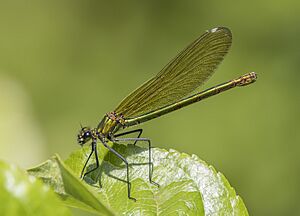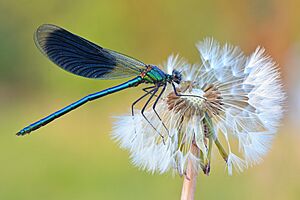Banded demoiselle facts for kids
Quick facts for kids Banded demoiselle |
|
|---|---|
 |
|
| Male | |
 |
|
| Female | |
| Conservation status | |
| Scientific classification | |
| Genus: |
Calopteryx (damselfly)
|
| Species: |
splendens
|
The banded demoiselle (Calopteryx splendens) is a beautiful type of damselfly. These insects are often seen flying near slow-moving streams and rivers. You can find them across a huge area, from the Atlantic coast of Europe all the way to Lake Baikal in Asia and parts of northwestern China. They are quite common in many places where they live.
Contents
What Does the Banded Demoiselle Look Like?
This is a fairly large damselfly. It can grow up to about 1.9 inches (48 mm) long. Its back wings can be up to 1.4 inches (36 mm) long.
Male Banded Demoiselle
Male damselflies have wings that you can see through. Each wing has a wide, dark, shiny blue-black spot or band across the outer part. If a male is still young, this spot will be dark brown. Their bodies can be a metallic blue, a bluish-green, or a mix of both. This depends on the time of year and where they live.
The dark patch on the male's wing starts at a small dip called the nodus. In some southern areas, this patch can even reach the very tip of the wing. Another damselfly, the beautiful demoiselle (Calopteryx virgo), looks very similar. However, its dark wing patch starts before the nodus.
Female Banded Demoiselle
Female damselflies have wings that are also see-through. Their wings are usually a pale green color and look shimmery. Near the tip of each wing, there is a small white patch. Their bodies are typically a metallic green or a bronze-green color.
Life Cycle: From Egg to Adult
Female banded demoiselles are busy egg-layers. They can lay up to 10 eggs every minute for about 45 minutes! They lay their eggs on many different kinds of plants that grow in or float on the water. Sometimes, they even go underwater to lay their eggs.
Larvae Development
The eggs hatch after about two weeks (14 days). The young damselflies are called larvae. They have very long legs and look a bit like sticks. These larvae usually take about two years to grow. They can live in muddy water and often spend the winter buried in the mud. When a larva is ready to become an adult, it climbs out of the water onto a plant. Then, it sheds its skin to become a beautiful adult damselfly.
Where Do Banded Demoiselles Live?
These damselflies enjoy many types of freshwater places. They especially like open, flowing water bodies, such as streams and smaller rivers.
How Do Banded Demoiselles Behave?
Male banded demoiselles usually like to have their own space. They are often territorial, meaning they defend their area. However, you can sometimes find many of them together in thick plants along the riverbanks or on things floating in the water.
Courtship Dance
When a male wants to attract a female, he performs a special aerial dance. He opens his wings and flies in a unique way to impress her. You will often find these damselflies in canals and calm rivers that have muddy bottoms, especially in open countryside areas.
Where Can You Find Banded Demoiselles?
The banded demoiselle is found across a large part of Eurasia. Its range stretches from the Atlantic coast of Europe all the way to Lake Baikal and northwestern China. You can find them in places like Taganay and Zyuratkul National Parks in Russia. They also live at Fruška Gora in Serbia. In the British Isles, they are common everywhere except for the Scottish Highlands.
Gallery











